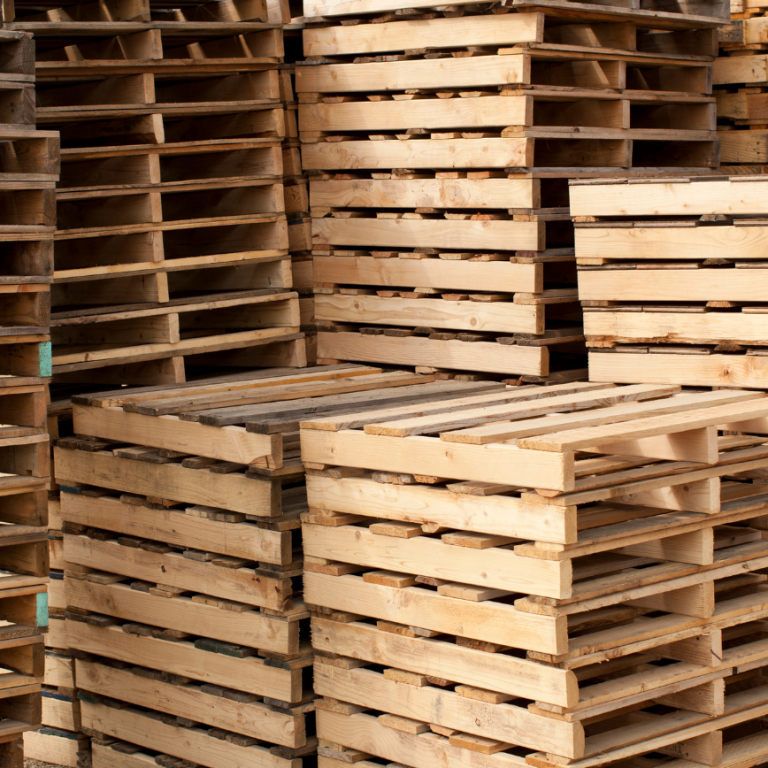
Pallet Wood- Is it Safe?
Reclaimed pallet wood has become a staple in the world of DIY, offering an affordable and eco-friendly option for creating rustic furniture, garden beds, wall décor, and more. The weathered texture and charm of pallet wood make it a popular choice for those looking to add character to their homes. However, beneath its rough exterior lies a potential risk: contamination.
Not all pallet wood is safe for indoor or outdoor use, and some pallets may harbour harmful chemicals, pesticides, bacteria, or mould. This contamination can pose serious health risks if not properly identified and managed. Understanding the sources and types of contamination is crucial for anyone considering using pallet wood in their projects.
Why is Pallet Wood Contaminated?
Pallets are widely used in the shipping industry to transport goods across long distances. During their lifecycle, pallets may be exposed to various chemicals, weather conditions, or even pests. Pallets are often stacked in warehouses, left outdoors, or repurposed, which increases the likelihood of contamination.
Key sources of contamination
Chemical treatments
Pallets are often treated with chemicals to prevent decay, mould, and insect infestation. The two most common treatments are:
- Methyl Bromide (MB): This is a highly toxic pesticide used in fumigation, particularly in pallets for international shipping. Methyl bromide exposure can cause respiratory problems, skin irritation, and neurological damage.
- Heat Treatment (HT): A safer alternative, heat-treated pallets are heated to a specific temperature to kill pests without chemicals. These are marked with "HT" and are generally considered safer for DIY use.
Spillages and Contaminants
Pallets used to transport chemicals, oils, paints, or hazardous materials may absorb spills and retain these contaminants. These invisible toxins can leach into the wood and later be released into the air or absorbed through skin contact.
Mould and Bacteria
Pallets stored in damp environments can harbour mould or bacteria, especially if exposed to moisture for prolonged periods. This can be a significant risk for indoor furniture or projects in contact with food, such as garden beds or kitchen table
Risks of Using Contaminated Pallet Wood
The potential dangers of using contaminated pallet wood are not always immediately apparent, but they can have serious long-term consequences. Some of the key health and safety risks include:
Respiratory Problems
Exposure to chemical-treated pallets, particularly those treated with methyl bromide, can cause respiratory issues, especially when the wood is cut or sanded, releasing toxic dust into the air.
Food Safety
Handling contaminated wood may lead to skin irritation, rashes, or allergic reactions, especially if the wood has absorbed chemicals or oils.
Skin Irritation
Using contaminated pallet wood for garden beds, cutting boards, or kitchen furniture can introduce harmful chemicals into the soil or food. These chemicals can be absorbed by plants or transferred to food prepared on the wood, leading to ingestion of toxins.
Structural Integrity
Pallets exposed to the elements may have weakened wood, mould, or rot, making them structurally unsafe for heavy furniture or outdoor projects. Mould spores can also trigger allergies or respiratory problems indoors.
Identifying Safe Pallet Wood
Before using pallet wood, it is essential to inspect it carefully and ensure it is free from contaminants. Here's what to look out for:
Appearance and Smell
Pallets that look discoloured, stained, or have an oily residue should be avoided. These signs often indicate chemical exposure. Additionally, pallets that emit a strong odour (other than typical wood smells) could be contaminated with chemicals or other harmful substances.
Markings
Pallets used for international shipping are often stamped with codes that provide information about their treatment. Look for these key markings:
- HT (Heat Treated): Indicates the pallet was treated with heat, which is safe for reuse.
MB (Methyl Bromide): Avoid these pallets at all costs, as they are treated with toxic chemicals. - DB (Debarked): The pallet has been stripped of its bark, which reduces the risk of mould but doesn’t indicate chemical treatment.
- Pallets without any markings may not have been treated at all, which can also be a risk as they may harbour pests or contaminants.
Country of Origin
Pallets manufactured in certain countries may be subject to less stringent treatment regulations. Be cautious of pallets from unknown sources or those with questionable histories.
Using Pallet Wood Safely
Despite the risks, pallet wood can still be used safely if proper precautions are taken. Here are some steps to minimize contamination risks:
Choose Wisely: Only use pallets marked with “HT” or those that you can verify have not been exposed to chemicals or hazardous materials. If you're unsure of a pallet's history, it’s best to avoid using it for indoor projects or food-related items.
Clean Thoroughly: Before working with pallet wood, clean it with a mixture of water, vinegar, and mild detergent. This will help remove surface dirt, mould, and potential contaminants. For stubborn stains or residues, use a power washer to deep clean the wood.
Sand and Seal: Sanding the wood smooths the surface and removes any splinters or rough edges. Be sure to wear protective gear, such as a mask and goggles, to avoid inhaling dust. After sanding, sealing the wood with a non-toxic sealant or varnish can create a protective barrier that reduces exposure to any lingering contaminants.


Final Thoughts
Pallet wood can be a fantastic resource for DIY enthusiasts, offering affordability, sustainability, and unique character. However, understanding the risks of contamination is essential to ensuring that your creative projects don’t come at the cost of your health. By choosing safe pallets, cleaning them thoroughly, and sealing them properly, you can enjoy the rustic charm of pallet wood without the hidden dangers.
As with any DIY project, it’s always better to err on the side of caution. When in doubt, opt for wood from a trusted source to ensure your projects are as safe as they are beautiful.
©Copyright. All rights reserved.
We need your consent to load the translations
We use a third-party service to translate the website content that may collect data about your activity. Please review the details in the privacy policy and accept the service to view the translations.
